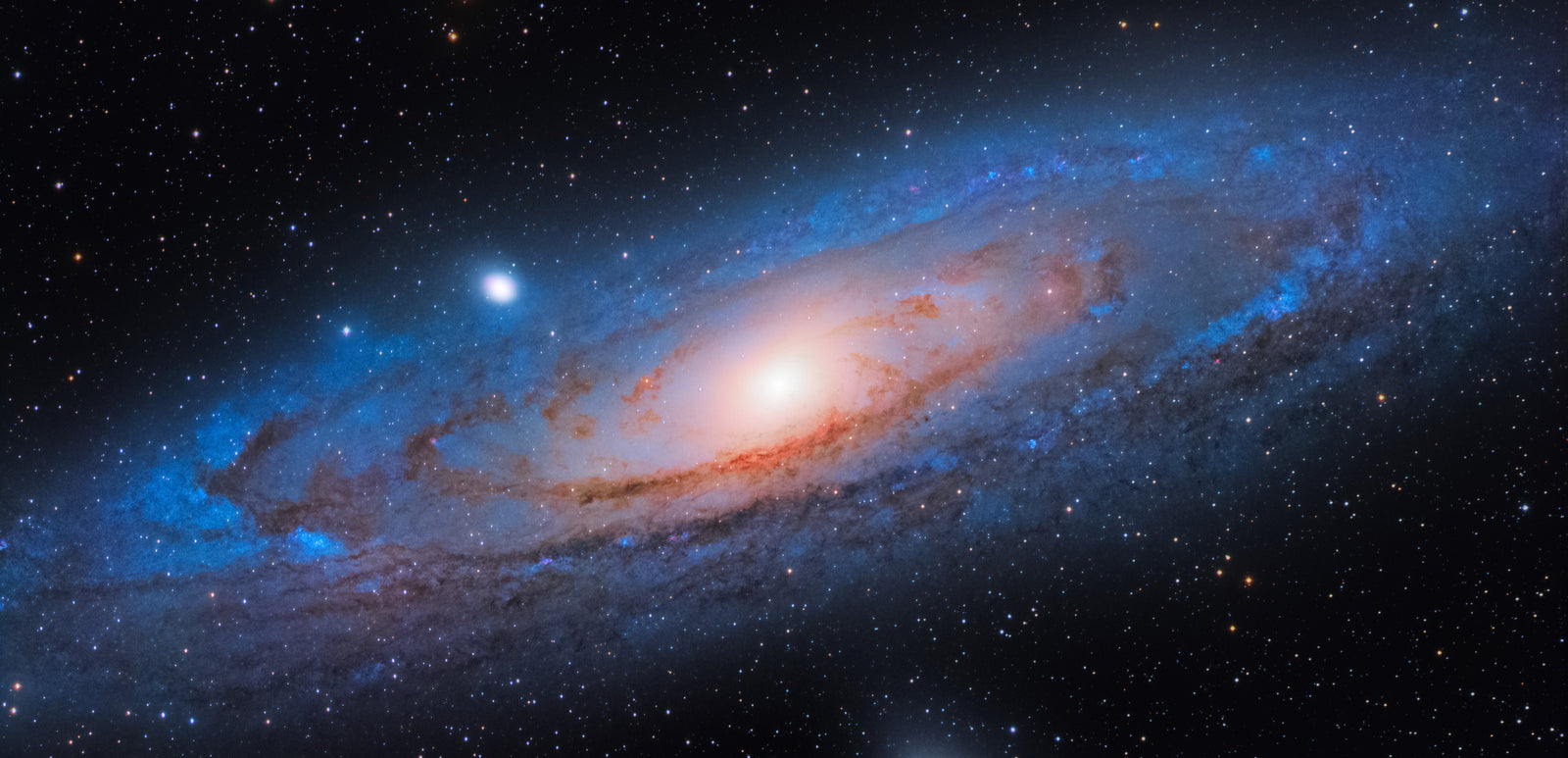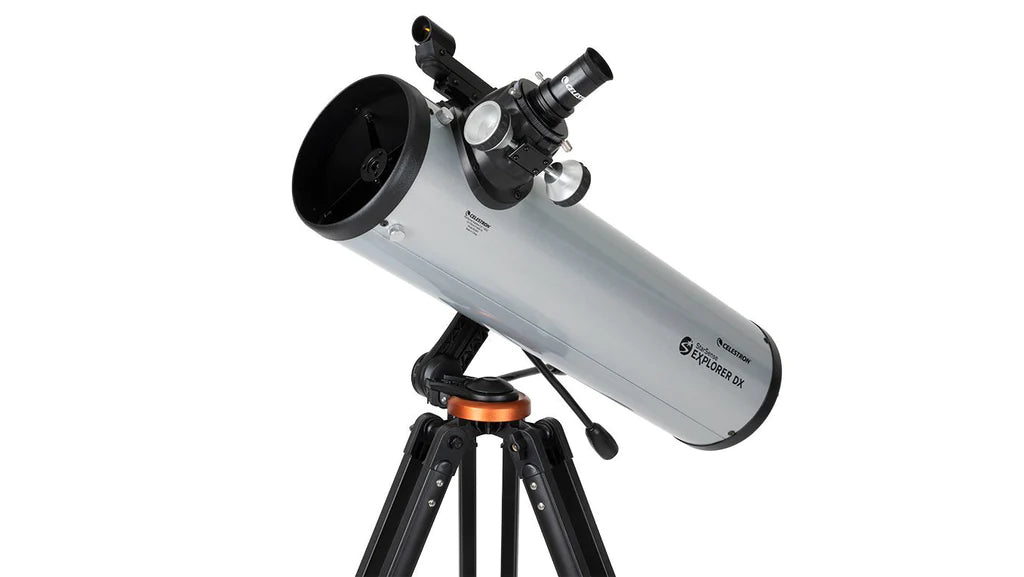How Reflecting Telescopes Work
Reflecting telescopes use mirrors to focus light and magnify an image. Compared to refractor telescopes, reflectors are usually significantly larger telescopes. This is because it is less expensive to produce a large aperture reflector telescope compared to a refractor. Newtonians and Dobsonians in particular can be had at a very affordable price for a large aperture, making them an excellent choice for visual observers. If you've ever attended a star party, you'll notice that most visual observers are using Dobsonians for this reason. Other common reflector designs include the Ritchey-Chretién, which many famous telescopes like the Hubble Space Telescope utilize for its premium optical performance.
Why is a Large Aperture, or Objective Important?
Telescopes work by magnifying light to enlarge views of the night sky. The more light that a telescope gathers, the brighter the magnified view will be. Because it costs less to manufacture a mirror than a lens, reflector telescopes can be made with large objective mirrors while still being affordable to own. We recommend you purchase the largest aperture reflecting telescope that fits your budget, as the views from these large telescopes are hard to beat. They'll give you close up views of some of the dimmest, but most interesting objects in the night sky.
Do Reflecting Telescopes Require Maintenance?
For as affordable as they are, nearly all reflectors will require more maintenance than other telescopes like refractors. Reflectors usually need to be collimated, which is the process of precisely aligning the mirrors in the telescope using simple tools. A telescope that is out of collimation will be impossible to focus perfectly.
Collimation might sound scary, but it's actually quite simple, and can be compared to the need to tune an instrument before you play it. Without tuning, an instrument just won't sound right. Without collimation, a telescope just won't see right. The additional cost of collimation tools such as a good laser collimator is something to take into account when purchasing any reflecting telescope, as they're often not included in the purchase, but are a required tool.
Why do Reflecting Telescopes Have Diffraction Spikes?
Have you ever wondered why images from the Hubble Space Telescope have four-pointed, cross-shaped stars? The answer is diffraction spikes. All reflector telescopes will exhibit these multi-pointed stars because of their design. You'll notice that in any reflector telescope, whether it be a Newtonian, Ritchey-Chretién, or any other, the secondary mirror is held up by multiple spider vanes. These spider vanes, or struts, are what cause the light to diffract and produce spikes on bright stars.
Is A Reflecting Telescope Right For Me?
Dobsonians are a great choice for visual observers, and are without a doubt the best telescope design for those that want to look through an eyepiece to view the night sky. On the other hand, Newtonians and Ritchey-Chretiéns can make great telescopes for astrophotography. However, since reflectors require collimation and are usually much larger and heavier than refractors, we don't usually recommend them as a beginner deep sky astrophotography telescope. Instead, we would recommend a small refractor for its ease-of-use, portability, and lack of maintenance required. Continue reading below to find out the pros & cons of each type of reflector optical design and help you narrow down which one is best for you.
Advantages & Disadvantages of Reflecting Telescopes
Advantages: One of the biggest positives of reflecting telescopes is that it's free of chromatic aberration. Which means you will usually get very crisp and clean images and views without color banding at the edges of stars. The cost is also one of the advantages of going with a reflecting telescope. You can usually get a larger aperture telescope for a lower cost when compared to other telescope types.
Disadvantages: These telescopes can tend to have an open tube design which can lead to increased maintenance. Because of these open areas the mirrors must be cleaned periodically. As mentioned above, reflector telescopes also require collimation. Without doing that you may see blurry images. Larger apertures usually result in a very big telescopes which can be difficult to transport from place to place. Most people do not consider this when purchasing a telescope, but it is something that needs to be considered.
Types of Reflecting Telescopes
Newtonian Telescopes
Best for experienced imagers who want a large aperture telescope
Newtonian telescopes are the classic reflector design, and use a primary and secondary mirror to project an image out the side of the optical tube and into your eyepiece. Newtonians are very affordable telescopes for their aperture, so you'll see them in a wide range of prices from beginner visual telescopes all the way up to advanced imaging telescopes.
Beginner visual Newtonians will usually come with a tripod mount to carry the telescope, whereas more advanced imaging Newtonians will often be sold as just the Optical Tube Assembly (OTA) only, without a mount. If you're a beginner looking for a strictly visual telescope, you may find that a Dobsonian is a better fit for your needs.
Imaging Newtonians can be a great way to get a fast focal ratio telescope for an affordable price, but they often require the additional purchase of a coma corrector and a good collimation tool. On top of this, Newtonians are usually much larger and heavier for astrophotography than similarly-priced refractors or SCTs. This means a large and heavy-duty mount is often required, and even small gusts of wind can affect tracking accuracy on such a large scope. Overall, imaging Newtonians can be a great bang-for-your-buck if you're willing to trade added cost and weight for a fast, large aperture telescope.
Explore Newtonian Telescopes
Dobsonian Telescopes

Best for visual observers of all skill levels who want the largest aperture that fits their budget
In visual astronomy, aperture is king. So it's no surprise that Dobsonians, which are the most affordable telescopes per inch of aperture, are the preferred choice of many visual observers. Dobsonians excel at visually observation of just about any target, and they have a great reputation for being able to observe faint deep sky objects like galaxies in particular.
The telescope portion of a Dobsonian is really just a Newtonian, but Dobsonian refers to the type of mount the telescope rests on. This simple-to-use swivel mount design makes it effortless to point the telescope, even with large sized Dobs. It's safe to say that Dobsonians are excellent telescopes for all skill levels. For beginners and traveling observers, they even come in a smaller and more portable tabletop variety.
Dobsonians only have two main drawbacks other than the need for collimation. First, most Dobsonians starting around 10" (250mm) or larger can become very heavy and difficult to transport. Be prepared to do some heavy lifting if you're interested in a large Dobsonian. The second drawback to those interested in astrophotography is that they are primarily visual telescopes. Dobsonians can offer some good planetary images with a planetary camera, but cannot be used for deep sky imaging due to their alt-az style mount. These minor drawbacks aside, Dobsonians are hard to beat for all-around visual observing performance.
Explore Dobsonian Telescopes
Ritchey-Chretién Telescopes

Best for deep sky imagers who want a long focal length scope with great optics
The Ritchey-Chretién, or RC for short, is a specialized reflector design that is excellent at long focal length, deep sky imaging. If you're hoping to primarily image distant galaxies or just get close-up views of deep sky objects in general, an RC may be right for you.
Unlike a Newtonian or many refractors where additional accessories are needed to begin serious imaging, RCs are some of the best out-of-the-box astrophotography telescopes. Featuring a coma-free design, RCs suffer from very few optical aberrations (imperfections), making them ideal for serious imagers. Due to a large central obstruction, which is where the secondary mirror obstructs the light path, RCs tend to have lower natural contrast than other optical designs and therefore aren't as ideal for planetary imaging like Schmidt-Cassegrains are. This also means poor visual performance, so we don't recommend buying an RC for visual use.
RCs also feature slow focal ratios, which make them great for distant objects, but generally require longer exposure times than faster telescopes. This also means they are rather unforgiving telescopes in terms of tracking errors, and for that reason RCs are not recommended for beginning imagers. The slow focal ratio can, however, be alleviated somewhat with the use of a focal reducer. Overall, RCs are limited in their use, but excel at what they're made for: imaging distant deep sky objects.
Explore Ritchey-Chretién Telescopes
Dall-Kirkham & Cassegrain Telescopes

Best for planetary observers & imagers who want a design free of refractive elements
Telescopes like the Classic Cassegrain and the (non-corrected) Dall-Kirkham designs are excellent reflectors that are primarily used for high-end planetary viewing and imaging. Since these telescopes use an all-mirrored design, they are generally considered superior to other planetary telescopes like Schmidt-Cassegrains or Refractor telescopes which use glass lens elements that can introduce chromatic aberration.
Classic Cassegrains and Dall-Kirkhams do not suffer from any chromatic aberration and have very long native focal ratios, making them the ideal choice for high-end and research-grade planetary observing. Most of these telescopes are very expensive, but excel at long focal length viewing and imaging.
Explore Cassegrain & Dall-Kirkham Telescopes













